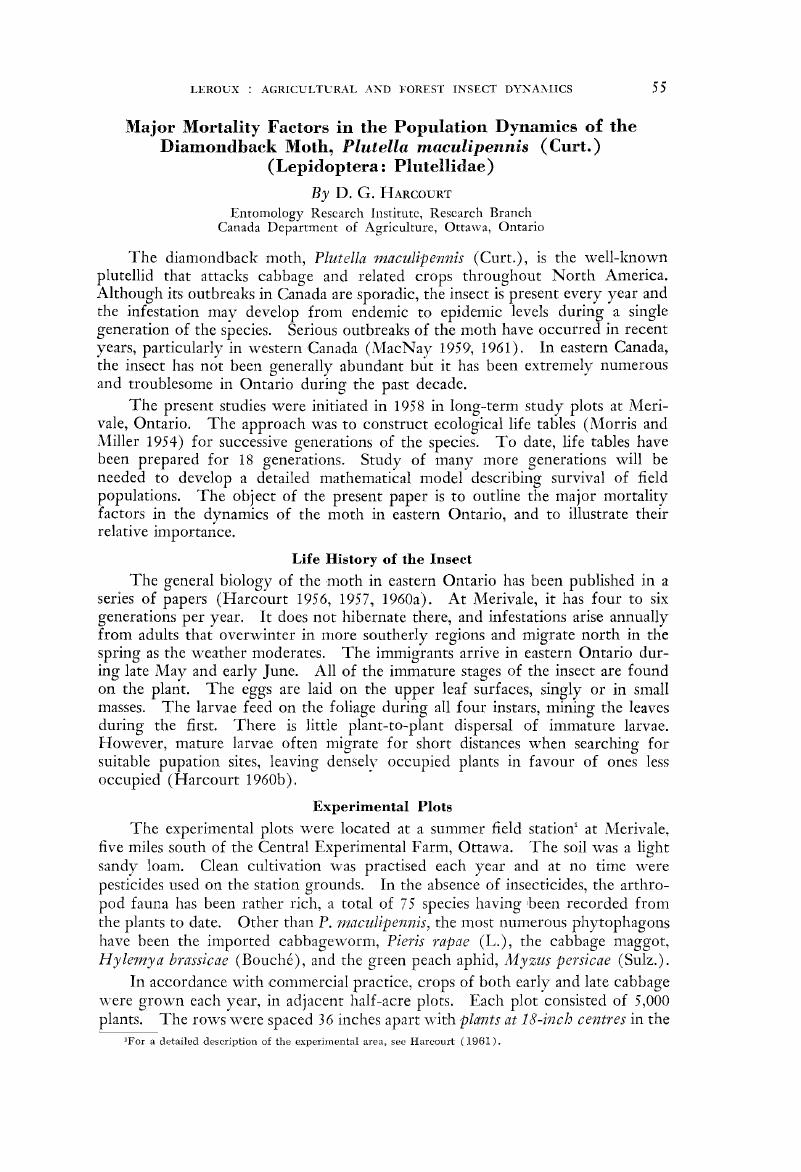Crossref Citations
This article has been cited by the following publications. This list is generated based on data provided by Crossref.
Paradis, Rodolphe-O.
and
LeRoux, E. J.
1965.
Recherches sur la Biologie et la Dynamique des Populations Naturelles d'Archips argyrospilus(Wlk.) (Lépidoptères: Tortricidae) dans le Sud-ouest du Québec.
Memoirs of the Entomological Society of Canada,
Vol. 97,
Issue. S43,
p.
5.
Embree, D. G.
1965.
The Population Dynamics of the Winter Moth in Nova Scotia, 1954–1962.
Memoirs of the Entomological Society of Canada,
Vol. 97,
Issue. S46,
p.
5.
HARCOURT, D. G.
and
CASS, L. M.
1966.
Photoperiodism and Fecundity in Plutella maculipennis (Curt.).
Nature,
Vol. 210,
Issue. 5032,
p.
217.
Harcourt, D. G.
1966.
Major Factors in Survival of the Immature Stages of Pieris rapae (L.).
The Canadian Entomologist,
Vol. 98,
Issue. 6,
p.
653.
Embree, D. G.
1966.
The Role of Introduced Parasites in the Control of the Winter Moth in Nova Scotia.
The Canadian Entomologist,
Vol. 98,
Issue. 11,
p.
1159.
Beirne, Bryan P.
1970.
EFFECTS OF PRECIPITATION ON CROP INSECTS.
The Canadian Entomologist,
Vol. 102,
Issue. 11,
p.
1360.
Strong, Frank E.
Sheldahl, J. A.
Hughes, P. R.
and
Hussein, Esmat M. K.
1970.
Reproductive biology ofLygus hesperusKnight: III. Modification of reproduction inLygus hesperus.
Hilgardia,
Vol. 40,
Issue. 4,
p.
133.
Price, Peter W.
1975.
Evolutionary Strategies of Parasitic Insects and Mites.
p.
87.
Lee, Kwang Yun
Barr, Robert O.
Gage, Stuart H.
and
Kharkar, Anil N.
1976.
Formulation of a mathematical model for insect pest ecosystems—The cereal leaf beetle problem.
Journal of Theoretical Biology,
Vol. 59,
Issue. 1,
p.
33.
van den Bosch, Robert
Messenger, P. S.
and
Gutierrez, A. P.
1982.
An Introduction to Biological Control.
p.
95.
DEMPSTER, J. P.
1983.
THE NATURAL CONTROL OF POPULATIONS OF BUTTERFLIES AND MOTHS.
Biological Reviews,
Vol. 58,
Issue. 3,
p.
461.
Bilapate, G G
1985.
Investigations onHeliothis armigera (Hubner) in Marathwada-XXVIII. Key mortality factors in regular and overlapping generations on pigeonpea.
Proceedings: Animal Sciences,
Vol. 94,
Issue. 5,
p.
463.
SIVAPRAGASAM, Annamalai
and
SAITO, Tetsuo
1986.
A Yellow Sticky Trap for the Diamondback Moth Plutella xylostella (L.) (Lepidoptera : Yponomeutidae).
Applied Entomology and Zoology,
Vol. 21,
Issue. 2,
p.
328.
Srinivasan, K.
and
Veeresh, G. K.
1986.
The Development and Comparison of Visual Damage Thresholds for the Chemical Control of Plutella Xylostella and Crocidolomia Binotalis on Cabbage in India.
International Journal of Tropical Insect Science,
Vol. 7,
Issue. 4,
p.
547.
Palaniswamy, P.
Gillott, C.
and
Slater, G.P.
1986.
ATTRACTION OF DIAMONDBACK MOTHS, PLUTELLA XYLOSTELLA (L.) (LEPIDOPTERA: PLUTELLIDAE), BY VOLATILE COMPOUNDS OF CANOLA, WHITE MUSTARD, AND FABA BEAN.
The Canadian Entomologist,
Vol. 118,
Issue. 12,
p.
1279.
Horn, D. J.
1987.
Vegetational background and parasitism of larval diamond‐back moth on collards.
Entomologia Experimentalis et Applicata,
Vol. 43,
Issue. 3,
p.
300.
McClure, Mark S.
1988.
Dynamics of Forest Insect Populations.
p.
45.
SIVAPRAGASAM, Annamalai
SAITO, Tetsuo
and
ITO, Yosiaki
1988.
Marking Adult Diamondback Moth, Plutella xylostella (L.), and Estimation of Adult Survival Rate and Population Density in a Cabbage Field.
Applied Entomology and Zoology,
Vol. 23,
Issue. 3,
p.
245.
Annamalai, Sivapragasam
Itô, Yosiaki
and
Saito, Tetsuo
1988.
Population fluctuations of the diamondback moth, Plutella xylostella (L.) on cabbages in Bacillus thuringiensis sprayed and non sprayed plots and factors affecting within‐generation survival of immatures.
Population Ecology,
Vol. 30,
Issue. 2,
p.
329.
Fahrig, L.
1988.
A general model of populations in patchy habitats.
Applied Mathematics and Computation,
Vol. 27,
Issue. 1,
p.
53.



